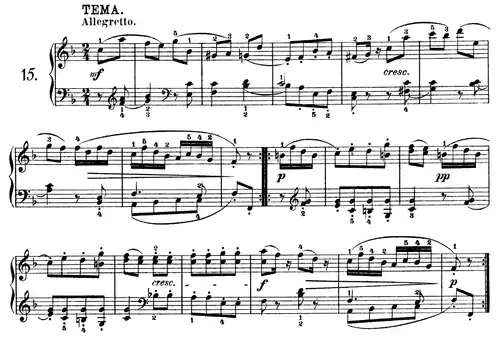Piano Sonata in F major, K. 547a
Wolfgang Amadeus Mozart's Piano Sonata in F major, K. 547a (Anh. 135) is a sonata in two movements. It was originally published as an original sonata by Breitkopf and Härtel in 1799 but was soon found to be an amalgam of movements culled from other compositions. It is sometimes called Mozart's Piano Sonata No. 19.

Theme from the variations, K. 54/547b, sometimes played as an additional third movement to this piece. This score has many additional editorial markings not written by Mozart himself.
Movements
The work has two movements:
- Allegro (a solo-piano transcription of the second movement of the violin sonata, K. 547)
- Allegretto (a transposition of the finale to the C major "Sonata Facile" into F major)
The set of six keyboard variations on an original Andante, K. 54/547b are sometimes played as an additional third movement to this piece. These variations are themselves also transcribed from the same violin sonata (K. 547) as the Allegro with its fourth variation (which was violin-centric in the original) re-written.[1]
Notes
- Zaslaw, Neal, with Cowdery, William eds., The Compleat Mozart: A Guide to the Musical Works of Wolfgang Amadeus Mozart, p. 320, New York: W.W. Norton & Co., 1990, ISBN 0-393-02886-0
External links
- Piano Sonata in F major, K.Anh.135/547a: Scores at the International Music Score Library Project
- Thema in F mit fünf Variationen KV Anh. 138a (KV 547a, 3. Satz): Score and critical report (in German) in the Neue Mozart-Ausgabe (Third movement, K. 54/547b)
- The Complete Mozart Piano Sonatas / Rodrian - MIDI files of the work. Here this sonata is moved into the canon and is placed as Piano Sonata No. 16, thus pushing the Sonata facile down to No. 17.
This article is issued from Wikipedia. The text is licensed under Creative Commons - Attribution - Sharealike. Additional terms may apply for the media files.